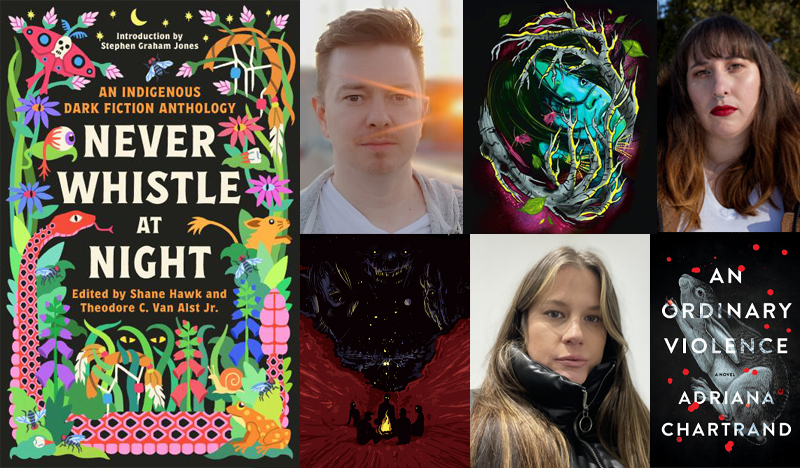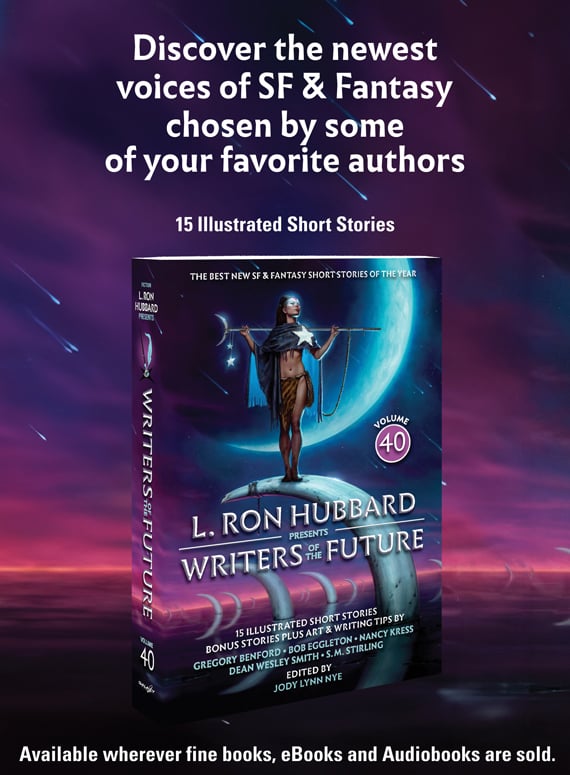
Clockwise from top left: Christopher Twins, detail from And Then She Fell, Alicia Elliot (Alex Jacobs-Blum), Adriana Chartrand, detail from Bad Medicine.
The explosion of Indigenous literary talent has launched an invigorating reverse-colonization of genre fiction: freed from staid expectations that we will limit ourselves to naturalistic and didactic narratives designed for the consumption and edification of white readers, Indigenous writers are transforming the formulaic, familiar beats of genre fiction into something new.
Horror, a genre rooted in the creative exploration of trauma that finds catharsis by giving vivid form to our deepest fears and most primal wounds, is an especially pertinent niche. Indigenous authors are drawing on generations of accumulated traumas, many of which are unfathomably chilling. But horror also has space for humour and surprise, and Indigenous storytelling has always mingled the tragic with the comic. Whistling in the dark may summon spirits, but laughing in the dark is a survival tactic.
Author Drew Hayden Taylor, whose horror novel Cold (McClelland & Stewart) will debut in January 2024, points out that the realities of Indigenous survival under colonialism trump any fictional exercise. “I mean … does anything really beat the fear of having your children taken away? And them being buried in unmarked graves?” he tweeted in early September 2023. With the gruesome discovery of hundreds of graves at former residential school sites across Canada, beginning with the former Kamloops Indian Residential School in May 2021, the brutality endured by Indigenous people feels inescapably present and increasingly urgent – particularly as some settlers have rushed to deny the possibility of such graves, a fresh injustice that magnifies the tragedy.
So perhaps it’s no surprise that so many Indigenous writers are turning to horror, an expansive and imaginative genre that allows them to convey the emotional and psychological effects of living through an endless, mutating genocide. As slasher-author Stephen Graham Jones explains in the foreword to Never Whistle at Night: An Indigenous Dark Fiction Anthology (Random House Canada), an eclectic collection of Indigenous short fiction published in September, horror “expand[s] the borders of the real” to allow two timelines – the past and the present, the legacy of colonialism and the world of the story – “to simultaneously exist. No, not just exist, but intersect.” The collection, edited by Shane Hawk (who also contributed a story) and Theodore C. Van Alst Jr., features well-known writers such as Cherie Dimaline, Waubgeshig Rice, and Richard Van Camp, as well as an array of burgeoning talents. With 26 tales to peruse, there are many standouts, including “Kushtuka,” by Mathilda Zeller, a propulsive story of a young woman stalked by a ghastly doppelgänger unseen by the white men around her – men who may pose a greater threat; and “Capgras,” Tommy Orange’s story of an author beset by an unsettling transformation while being misread on a disorienting book tour overseas. Brandon Hobson’s “The Ones Who Killed Us” is a particularly gorgeous, lyrical tale of vengeance wrought by a chorus of murdered Cherokee men: “They had no refuge even in the darkness of the trees or in the water, and without undressing they harbored no illusions about their safety because they could hear our steps on the twigs and rocks like the panting of hungry, angry beasts, craving the revenge of slaughter so that they would look into our squalid stares, their power dissolving, and see our fury before they died.”
Many of the stories in Never Whistle at Night evoke the rhythm and intimacy of a campfire story, a ritual at the heart of nehiyaw artist Christopher Twin’s graphic novel Bad Medicine (published by Conundrum Press under its YA graphic novel imprint Emanata later this month). The tales told by a group of teens gathered around a fire draw on Cree mythology and legend even as they echo the real-life contemporary horrors that stalk Indigenous youth; supernatural threats are matched by the sinister predators who travel along the darkened highways where young women disappear. Twin’s moody illustrations set a pitch-perfect atmosphere of creeping dread, and the slim collection can be devoured in a single evening.
Adriana Chartrand’s An Ordinary Violence (House of Anansi Press, this month) and Alicia Elliott’s And Then She Fell (Doubleday Canada, September) both explore the unsettling, alienating reality of existing in a white space as a young Indigenous woman, alongside supernatural manifestations of grief and trauma. In Chartrand’s debut novel, a young woman named Dawn returns to her hometown after her fledgling adult life in Toronto falls apart, arriving as her brother is released from prison. Haunted by sporadic, cryptic messages from her dead mother, Dawn senses something is not quite right with her brother and his disturbing new friend Tyler. The supernatural elements are less fully realized than the quotidian horrors surrounding Dawn: her grieving father’s isolation; her childhood friend’s miserable, empty marriage; the despair that replaces her excitement over a new job when she realizes she has been hired to fulfill a token Indigenous role. Chartrand appreciates how horror “gets to the truth of inner turmoil.” As she says by email, “as marginalized, racialized, oppressed people, Indigenous people experience a lot of everyday or normalized horrors, so there is a lot to draw from just from daily Indigenous life.”
And Then She Fell has drawn apt comparisons to Jordan Peele’s film Get Out, centring on a Mohawk writer and new mother named Alice who finds herself in a tony Toronto neighbourhood, surrounded by friendly white people – among them her perfect-seeming husband – harbouring hidden motives. But Elliott’s novel is deepened by a raw, harrowing depiction of mental illness, and an inventive exploration of storytelling as a form of inheritance and survival. Alice has experienced visions (or hallucinations) since childhood, and as she unravels after the birth of her daughter, the vivid scenes of her waking nightmares are genuinely terrifying. The book articulates how trauma compounds across generations, as well as the insidious dehumanization and objectification of Indigenous women that perpetuates violence against them. The redemptive, heart-rending final act of the novel bends space and time to consider “the connection and love that slides between all hardship and gives even the toughest life humor, meaning, heart, heft” – flawed and damaged people still reach out their arms to catch one another when they fall.
Each work draws on the past while grounding the narrative firmly in the present. After all, the last residential school closed only 27 years ago; today, the “child welfare” system removes more Indigenous children from their families and communities than the residential school system ever did. The toxic drug crisis has significantly contributed to a seven-year drop in the life expectancy of First Nations people in Alberta since 2015. Indigenous girls and women are still six times more likely to be murdered.
These atrocities are happening now. They can be unbearable. But horror stories, with their bloody articulations of the unnameable and their cathartic depictions of vengeance, evoke the improbable survival of Indigenous people in the face of so much crushing violence. Our capacity to stare down the monster, to outrun it day by day.
Correction, Oct. 18: This story has been updated from the original to reflect that the friend in An Ordinary Violence is named Tyler, not Cody.
 Contact us via email
Contact us via email


